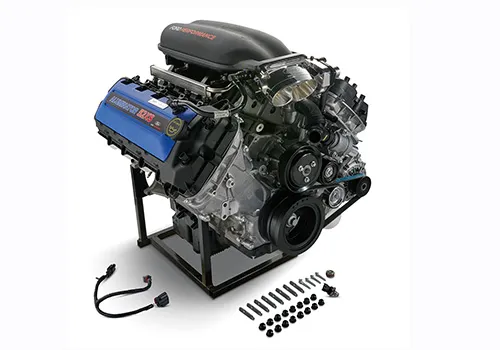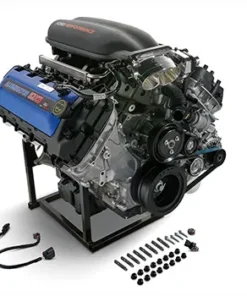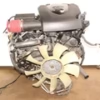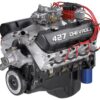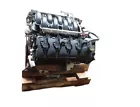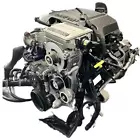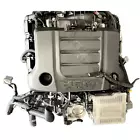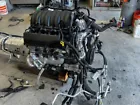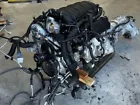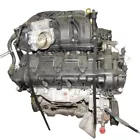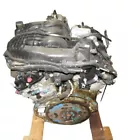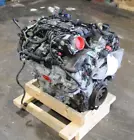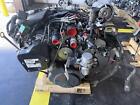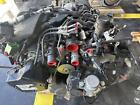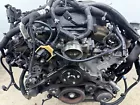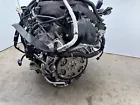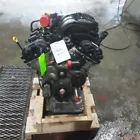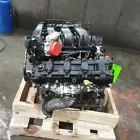FORD 5.2L ENGINE
$18,000.0 Original price was: $18,000.0.$15,000.0Current price is: $15,000.0.
The Ford 5.2L engine refers to a 5.2-liter engine variant developed by Ford Motor Company, which has been used in a variety of performance-oriented applications, particularly in the Ford Mustang and Ford Shelby lineups. The most famous version of this engine is the 5.2L V8 in the Shelby GT350 and GT500 models. There are also newer iterations of the engine found in Mustang Mach 1 and other high-performance vehicle
The Ford 5.2L engine refers to a 5.2-liter engine variant developed by Ford Motor Company, which has been used in a variety of performance-oriented applications, particularly in the Ford Mustang and Ford Shelby lineups. The most famous version of this engine is the 5.2L V8 in the Shelby GT350 and GT500 models. There are also newer iterations of the engine found in Mustang Mach 1 and other high-performance vehicles.
Key Variants of the Ford 5.2L Engine
-
5.2L V8 “Voodoo” Engine (Found in the Shelby GT350)
-
5.2L V8 “Predator” Engine (Found in the Shelby GT500)
-
5.2L V8 “Cammer” Engine (Used in limited performance applications)
Let’s dive into the key details of each one.
Ford 5.2L engine V8 “Voodoo”
The Ford 5.2L engine V8 “Voodoo” is a naturally aspirated Ford 5.2L engine V8 engine that Ford developed for the 2015-2020 Shelby GT350 and GT350R models. This engine is most notable for being hand-built and using a unique flat-plane crank design, which gives it its distinctive sound and performance characteristics.
Key Features of the Voodoo Ford 5.2L engine:
-
Displacement: 5.2L (319 cubic inches)
-
Configuration: V8, DOHC (Dual Overhead Camshaft)
-
Compression Ratio: 12.0:1
-
Induction Type: Naturally aspirated
-
Horsepower: 526 hp at 7,500 rpm
-
Torque: 429 lb-ft at 4,750 rpm
-
Redline: 8,250 rpm
-
Fuel System: Port fuel injection combined with direct injection
-
Bore x Stroke: 94.0mm x 93.0mm
Performance Characteristics:
-
Flat-plane crank design: The flat-plane crankshaft is one of the most defining features of the Voodoo engine. Unlike the more traditional cross-plane crankshaft used in most v Ford 5.2L engine
Ford 5.2L engine V8 engines, a flat-plane crank allows for higher RPMs, resulting in an engine that’s more responsive and rev-happy. This design is common in Ferrari and Lamborghini V8s, and it gives the Voodoo a distinctive exhaust note.
-
Rev-Happy Nature: This engine loves to rev, with a redline of 8,250 rpm, which is higher than most other naturally aspirated V8s in the market. This allows for quick acceleration and greater power at higher RPMs.
-
High-Performance Components: The Voodoo engine features high-performance rods, pistons, and valves, as well as a dual-mass flywheel and an aluminum alloy block for weight savings and rigidity.
-
Performance Applications: Found exclusively in the Shelby GT350 and GT350R, which are aimed at delivering track-ready performance with a focus on handling, braking, and overall driving dynamics.
Ford 5.2L engine V8 “Predator”
The 5.2L “Predator” V8 is the supercharged version of the 5.2L V8 family, found in the 2020+ Ford Mustang Shelby GT500. It takes the performance of the Voodoo engine and enhances it significantly with the addition of a supercharger, pushing the boundaries of power.
Key Features of the Predator Ford 5.2L engine
-
Displacement: 5.2L (319 cubic inches)
-
Configuration: V8, DOHC (Dual Overhead Camshaft)
-
Induction Type: Supercharged (via an Eaton supercharger)
-
Horsepower: 760 hp at 7,300 rpm
-
Torque: 625 lb-ft at 5,000 rpm
-
Compression Ratio: 9.5:1 (lower than the Voodoo for forced induction)
-
Fuel System: Direct fuel injection
-
Redline: 7,500 rpm
-
Bore x Stroke: 94.0mm x 93.0mm
Performance Characteristics:
-
Supercharged Power: The Predator engine is boosted by a 2.65L Eaton supercharger which allows it to deliver a massive 760 horsepower. This engine is built to deliver incredible straight-line speed and high-end performance for the Mustang GT500, making it one of the most powerful production Mustangs ever created.
-
Lower Compression for Forced Induction: The lower compression ratio of 9.5:1 is optimized for forced induction, allowing the engine to handle the increased pressure from the supercharger without risk of knocking or damaging internal components.
-
Torque Over 600 lb-ft: The 625 lb-ft of torque available at 5,000 rpm gives the GT500 an exceptional amount of pulling power, making it not only fast on the straights but also incredibly quick off the line.
-
Cooling & Durability: The engine is equipped with an advanced intercooler system to maintain optimal temperatures and prevent heat-related performance issues, which is critical when dealing with supercharged applications.
-
Performance Applications: Exclusively found in the 2020+ Ford Mustang Shelby GT500, which is a high-performance muscle car that competes with the likes of the Chevrolet Corvette Z06 and Dodge Challenger Hellcat.
Ford 5.2L engine V8 “Cammer”
The Cammer 5.2L is a more niche, high-performance crate engine created by Ford Performance, which is available for racing and specialized applications.
Key Features of the Cammer Ford 5.2L engine
-
Displacement: 5.2L (319 cubic inches)
-
Horsepower: 580+ hp (varies by build)
-
Induction Type: Normally aspirated or supercharged (depending on the build)
-
Applications: Designed primarily for motorsport or high-performance custom builds.
-
Customization: This engine can be customized with various options, including intake systems, exhaust headers, and camshaft configurations.
Modifying the Ford 5.2L engine
If you’re considering modifications to the Voodoo or Predator 5.2L V8, there are several performance upgrades you can explore to boost power and handling.
1. Cold Air Intake (CAI)
-
Why: A cold air intake improves airflow into the engine, resulting in more power and better throttle response. The added air density from a colder intake allows for more efficient combustion.
-
Expected Gains: Around 5–10 hp.
2. Exhaust System Upgrades
-
Cat-Back Exhaust or Long-Tube Headers: These reduce exhaust backpressure and increase exhaust flow, which enhances engine performance.
-
Expected Gains: 10–20 hp.
3. Supercharger Pulley and Tuning (for Predator)
-
For Predator engines, upgrading to a larger supercharger pulley and getting a custom tune can significantly boost performance.
-
Expected Gains: An increase of 50–100 hp depending on the pulley size and tuning.
4. ECU Tuning
-
Why: Tuning the ECU helps optimize the engine’s parameters, such as fuel mixture, timing, and airflow. Tuning can improve both power and efficiency.
-
Expected Gains: Up to 20–30 hp.
5. Performance Camshaft
-
Replacing the factory camshaft with an upgraded performance camshaft can change the timing of valve openings and closings, resulting in better high-RPM performance and more power.
-
Expected Gains: 10–25 hp, depending on the camshaft profile.
6. Forced Induction (Supercharger or Turbo)
-
If you’re starting with the Voodoo engine, you could add a supercharger or turbocharger to significantly increase horsepower. Aftermarket forced induction kits for the Voodoo engine are available.
-
Expected Gains: 100–250 hp or more, depending on the boost levels.
Reliability and Maintenance Tips
While the 5.2L engines, especially the Voodoo and Predator, are performance engines, maintaining them properly is crucial for long-term durability:
1. Oil Changes
-
Use high-quality synthetic oil. Change the oil at regular intervals—typically every 5,000 miles for regular driving and every 3,000 miles for track use or aggressive driving.
2. Cooling System
-
Supercharged engines (like the Predator) and naturally aspirated high-performance engines (like the Voodoo) are sensitive to heat. Make sure to regularly check the coolant levels and radiator condition.
3. Brake Maintenance
-
High-performance braking systems are vital for keeping up with the engine’s power. Keep your brake fluid and pads in good condition to avoid brake fade, especially under heavy use.
4. Spark Plugs and Ignition System
-
For supercharged engines like the Predator, you might need colder spark plugs to handle the increased power and heat from forced induction.
5. Timing Chains and Components
-
Regularly inspect the timing chains and related components, especially for the Voodoo engine, which operates at very high RPMs.
Ford 5.2L engine V8 in Summary:
-
Voodoo and Predator are the stars of the Ford 5.2L V8 lineup, offering high-revving naturally aspirated performance and supercharged insane power, respectively.
-
Both engines are finely tuned to balance performance, handling, and drivability.
-
The Voodoo is a fantastic choice for those seeking pure naturally aspirated performance, while the Predator is built for extreme straight-line speed.


